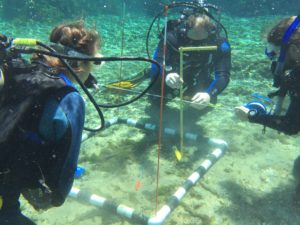This blog was provided by Chris McCarron, one of the supervisors participating in this year’s underwater archaeology field school program.
 The St. Augustine Lighthouse & Museum is currently under way with its annual underwater archaeology field school as students dive off the coast of St. Augustine to find long lost artifacts from colonial era North America. This year’s roster includes five students from the United States and Canada, all with different fields of academic studies and a shared interest in finding and preserving history.
The St. Augustine Lighthouse & Museum is currently under way with its annual underwater archaeology field school as students dive off the coast of St. Augustine to find long lost artifacts from colonial era North America. This year’s roster includes five students from the United States and Canada, all with different fields of academic studies and a shared interest in finding and preserving history.
Under the guidance of archaeologists in the Lighthouse Archaeological Maritime Program (LAMP), the team has returned to the “Storm Wreck” this year to continue excavating a colonial shipwreck of unknown name roughly a mile off the coast of St. Augustine Beach.
The Storm Wreck
This ship was part of a fleet that evacuated Charleston, S.C., in late 1782 and wrecked along with fifteen other evacuating vessels. The American Revolution was coming to an end and citizens loyal to the crown of England had to leave for the nearest safe port available to them, namely St. Augustine. These sixteen refugee vessels fell victim to the notoriously dangerous sandbars that surround the area and the artifacts that they left behind remain there to this day.
[Watch this video fore more history behind the Storm Wreck!]
The 2015 field school season began with a rigorous swim test and underwater obstacle course in order to help prepare the students for the commonly harsh conditions they are facing on the this wreck site. With their masks blacked out to simulate a zero-visibility situation, the student archaeologists had to maneuver an obstacle course covered in tangled lines, large barriers, and on-looking supervisors who were more than happy to attach a bungie cord to the first available piece of loose gear.
Check out this video documenting the underwater obstacle course experience:
On top of the difficult conditions, students were also given tasks to complete before being able to exit the course.
Carolane Veilleux, a field school student from Quebec, Canada, said that, “The training scared us so bad that all the work we actually did on site didn’t seem so hard after all! It is awesome!”
Challenges build teamwork
After the initial testing and training was completed, it was time to start working on the shipwreck. At first, searching for the dig site proved challenging. The same sandbars and harsh currents that sank the ship in the first place also had a hand in concealing the remains once again since the sight was last excavated a year ago. After days of hard work and due diligence, the LAMP crew’s training paid off and the sight was secured and readied for the upcoming excavating.
“We are really coming together as a team and are starting to work as an effective and efficient unit,” said Joshua Dotson, a Flagler College student in the program.
The students and rest of the crew will continue to work on the shipwreck until the end of this month and will continue to recover long lost pieces of some of America’s oldest history from the bottom of the ocean.

